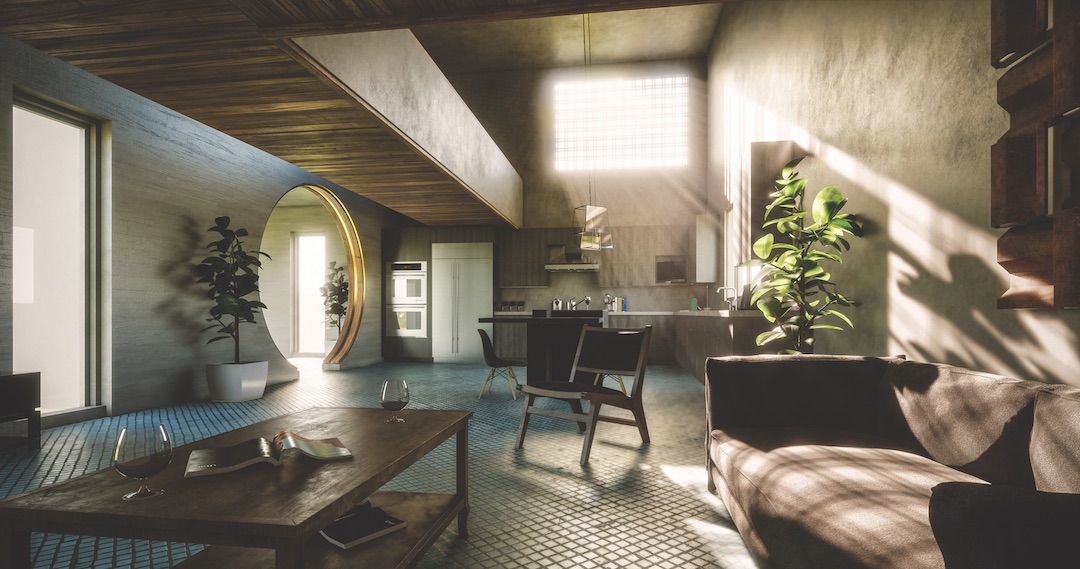During the past half-decade, a number of AEC technologies have sprung from a common, and perhaps unexpected, source: video games. From urban planning tools to the integration of VR, the well of video game inspiration springs eternal in the AEC world.
The newest tool to find a home in the kits of architects and designers has spent the last couple of decades being perfected by the video game industry: real-time rendering.
Real-time rendering, as its name would suggest, is focused on producing, altering, and analyzing images in real time. In the video game world, real-time rendering can be seen during game play; a character is controlled and the surrounding environment alters accordingly to simulate movement. A cutscene in a video game—when a player has no control—represents a more traditional, pre-rendered approach that is common in the AEC industry.
For AEC professionals, choosing real-time rendering techniques over more traditional rendering can mean the difference between making a change that is reflected instantaneously and making a change that may take a week or longer to be reflected in the project renderings. This swift turnaround can help firms save time and money and create a more streamlined experience for clients.
There are several software options: Enscape, eyecad VR, FluidRay RT, and Lumion. These tools work with programs such as SketchUp, Revit, and Rhino to enable real-time rendering and eliminate exporting modeling to another program.
With these tools, architects can make adjustments, large and small, to building plans. A designer using SketchUp with the Lumion Live Sync plug in, for example, can make necessary changes in the SketchUp model and see them reflected immediately in Lumion.
Users can move objects around, add different surface textures (e.g., polished, chrome, fabric), have lights or electronic screens emit illumination, and change sun settings. Realistic water, grass, time of day, and shadow effects can also be added and changed. In many cases, full visualizations can be created from an architectural model in 15 minutes.
Display settings can be changed for presentation purposes. Enscape’s Light View shows how much lux falls onto each surface in real time as the sun changes position throughout the day. If the date, time, and location have been selected, the sun angle will be displayed correctly.
 A before and after depicting Enscape’s real-time rendering software.
A before and after depicting Enscape’s real-time rendering software.
The single greatest benefit real-time rendering provides is better communication between an architect and a client. “It promotes active participation in design presentations and allows us to be more flexible,” says Phil Kolbo, LEED AP, Senior Architect and Associate Principal with Populous.
Traditional rendering methods require the design to be developed beforehand, so any requested changes need to be noted and executed at a later date. This means if a design team wants to present a client with three design options, four material choices, and six views, the presentation would require 72 different renderings. With real-time rendering, the design options can be changed in real time and the material options can be toggled on/off in seconds.
Orlando City Stadium, designed by Populous and opened in early 2017, is the result of this new real-time rendering approach. The 25,500-seat stadium’s seating bowl was designed in real time in front of the client group. The design team was able to test a variety of ideas as quickly as they or the client group could think of them. “As a result, the clients came to understand the site and stadium design limitations as much as we did, and we left the meeting with a greater level of trust from the clients,” says Kolbo.

Populous utilized real-time rendering tools to enhance client collaboration efforts on the 25,500-seat Orlando City Stadium.
Real-time peccadilloes
Just about any computer has the power to display traditionally rendered images without issue. But real-time rendering requires more powerful hardware, especially in the graphics department.
“Designers have to create models efficiently in order to achieve the best visual performance,” Kolbo says. “Strategies like advanced texturing and light baking can give models a life-like level of quality while still allowing them to run at a real-time level.”
Another consideration is allowing extra time for design and development. Because a client can request to see any part of a model at any time due to real-time rendering’s flexibility, all parts of the model need to be of high quality and ready to view.
“The technology behind real-time rendering software is constantly improving, but it currently calls for designers to make a choice between easy-to-use and non-customizable solutions or ones that are more complex and versatile,” says Kolbo. “Merging these points will unlock a lot more potential in the future.”
Real-time rendering still presents some trade offs when compared to traditional rendering. But as the technology advances, the benefits will begin to outweigh the limitations.
Related Stories
| Aug 11, 2010
Brad Pitt’s foundation unveils 14 duplex designs for New Orleans’ Lower 9th Ward
Gehry Partners, William McDonough + Partners, and BNIM are among 14 architecture firms commissioned by Brad Pitt's Make It Right foundation to develop duplex housing concepts specifically for rebuilding the Lower 9th Ward in New Orleans. All 14 concepts were released yesterday.
| Aug 11, 2010
City of Anaheim selects HOK Los Angeles and Parsons Brinckerhoff to design the Anaheim Regional Transportation Intermodal Center
The Los Angeles office of HOK, a global architecture design firm, and Parsons Brinckerhoff, a global infrastructure strategic consulting, engineering and program/construction management organization, announced its combined team was selected by the Anaheim City Council and Orange County Transportation Authority (OCTA) to design phase one of the Anaheim Regional Transportation Intermodal Center.
| Aug 11, 2010
Green consultant guarantees LEED certification or your money back
With cities mandating LEED (Leadership in Energy and Environmental Design) certification for public, and even private, buildings in growing numbers, an Atlanta-based sustainability consulting firm is hoping to ease anxieties over meeting those goals with the industry’s first Green Guaranteed.
| Aug 11, 2010
Architecture Billings Index bounces back after substantial dip
Exhibiting a welcome rebound following a 5-point dip the month prior, the Architecture Billings Index (ABI) was up almost 6 points in July. As a leading economic indicator of construction activity, the ABI reflects the approximate nine to twelve month lag time between architecture billings and construction spending. The American Institute of Architects (AIA) reported the July ABI rating was 43.1, up noticeably from 37.7 the previous month.
| Aug 11, 2010
Rafael Vinoly-designed East Wing opens at Cleveland Museum of Art
Rafael Vinoly Architects has designed the new East Wing at the Cleveland Museum of Art (CMA), Ohio, which opened to the public on June 27, 2009. Its completion marks the opening of the first of three planned wings.
| Aug 11, 2010
National Association of Governors adopts AIA policy of reaching carbon neutrality in buildings by 2030
As part of their comprehensive national Energy Conservation and Improved Energy Efficiency policy, the National Association of Governors (NGA) has adopted the promotion of carbon neutral new and renovated buildings by 2030 as outlined by the American Institute of Architects (AIA).
| Aug 11, 2010
AECOM, Arup, Gensler most active in commercial building design, according to BD+C's Giants 300 report
A ranking of the Top 100 Commercial Design Firms based on Building Design+Construction's 2009 Giants 300 survey. For more Giants 300 rankings, visit http://www.BDCnetwork.com/Giants
| Aug 11, 2010
HNTB, Arup, Walter P Moore among SMPS National Marketing Communications Awards winners
The Society for Marketing Professional Services (SMPS) is pleased to announce the 2009 recipients of the 32nd Annual National Marketing Communications Awards (MCA). This annual competition is the longest-standing, most prestigious awards program recognizing excellence in marketing and communications by professional services firms in the design and building industry.
| Aug 11, 2010
New book provides energy efficiency guidance for hotels
Recommendations on achieving 30% energy savings over minimum code requirements are contained in the newly published Advanced Energy Design Guide for Highway Lodging. The energy savings guidance for design of new hotels provides a first step toward achieving a net-zero-energy building.







